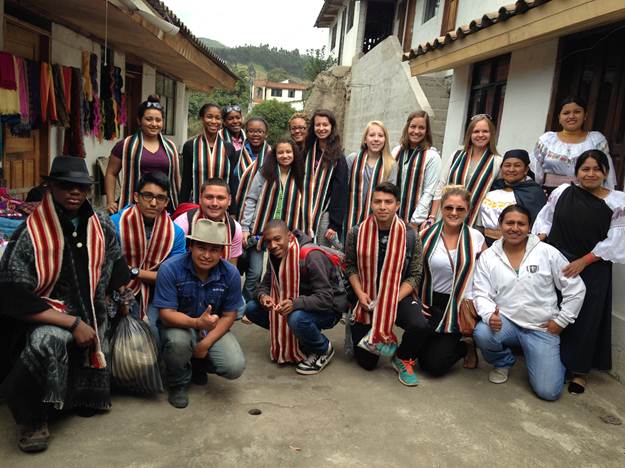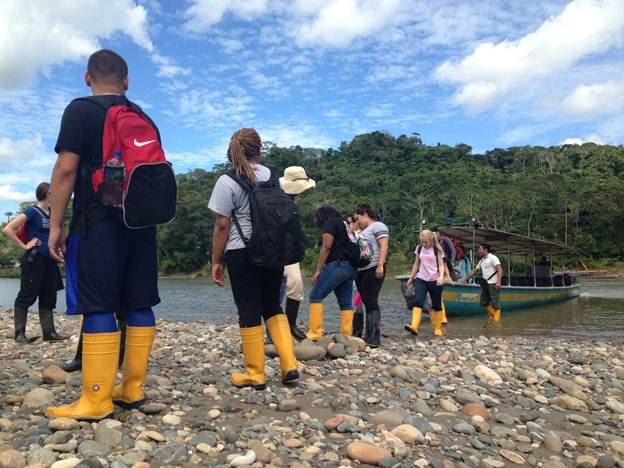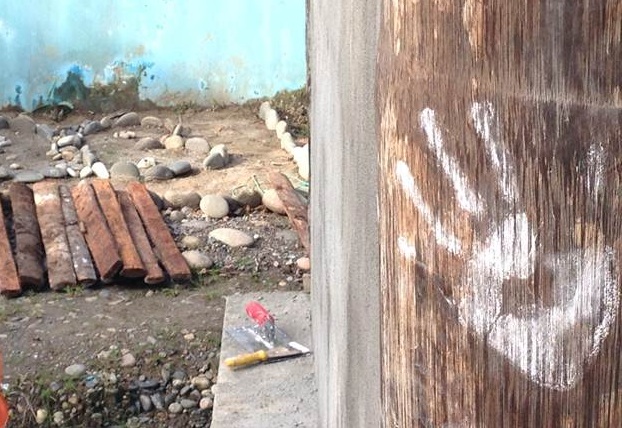We were descending from the highest altitude in the Amazon basin region. As the bus moved further down the mountain the temperature continued to climb. We were entering the Amazon rainforest and quickly began stripping off our coats, sweatshirts and hats to adapt to the newfound humidity. In a small country like Ecuador you wouldn’t expect the climate to change so frequently, but throughout our trip we would grow accustomed to this. One day it was frigid and windy, the next it was hot and humid.
We spent the day in Otavalo, a small rural town full of textile farms and markets selling authentic, indigenous items, such as alpaca ponchos – which came in handy with the shifting temperatures. Soon we were leaving the mountains behind and venturing into the rainforest. We were en route to the Minga Lodge, where we would partner with Free The Children and help assist with a local Amazon village service learning project.
“Rise and shine my little Rosebuds. We are at the port,” our Field Director, Rocio announced. “Welcome to the Amazon!” We all lifted our heads, and eagerly looked out the window to see where our Ecuadorian adventure had led us to next. One by one, all of us got off the bus, and headed to our next mode of transportation: a river boat! We strapped on our life jackets and took off along the Rio Napo with natural air-conditioning blowing against our faces.
Before we knew it, our “school bus” had docked, and we were greeted by the local staff with traditional, cinnamon flavored beverages. After getting settled and enjoying a nice dinner, together we took off our rain boots and gathered in a circle where Carolina, the project manager, met us.
“Welcome to the Minga Lodge!” Carolina said with excitement. “Does anyone know what minga actually means?” Blank faces glanced around at one another; it was clearly a foreign term to all of us. Carolina explained in simple terms that minga is when a community comes together to help support one another. She explained that minga is a Quechuan way of life that has existed in Ecuador for centuries, and that throughout Ecuadorian history the word has not lost any of its meaning. Even today, everyone in a given community holds the power of minga. Each person is entitled to call a minga in distressing times, and people will travel miles to gather around a project, family, or a single person that is in need of communal assistance. It is precisely what helps propel villages forward.
Carolina brought her discussion full circle and explained how history and culture had brought us to this very moment. She explained how minga was the cornerstone of the relationships that they had fostered with local villages, illustrating how she and her staff incorporated minga, local culture, and Amazonian traditions in their 5-year poverty alleviation plan. She then invited us all to take part in a very special minga in the tiny village of Mondana, just a short walk down the bank of the river.
Mondana has a population of about 150 people. Because the men are forced to travel long distances to find work, the village mostly consists of women and children. Within the village you’ll find several run down buildings, and until recently it lacked a clean, nearby water source. In five years’ time though, with the power of minga and dozens of international volunteers, the village will include a new school, a local clinic, community center and clean water.
During our project we collaborated with local villagers to build an indoor artist workspace within the community center. It was more than just a space for the blossoming artisan group to enjoy their craft. The workspace would also become a local art shop that will help provide Mondana with the self-generated income it needs to fund new education programs and build safe, modern infrastructure. This one workspace will help make Mondana a stronger, empowered and self-sustaining village!
We were excited and ready to kick-off our project, but we’d be lying if we said we weren’t also a bit nervous. We are without a doubt your average city girls. Back home we’d be heading to work with our hair curled and nails painted. But here we were in Ecuador with hard hats, work gloves and tools. Thankfully Wilmer had our back.
Wilmer was the site’s local village foreman and because of him we were all able to safely and successfully participate in the service project. Our lack of skill certainly didn’t make it easy for Wilmer, but he was patient and committed to helping us. One of our favorite memories was when Wilmer instructed us on how to spackle one of the workspace walls. The local villagers spoke little English and oftentimes we communicated our thoughts through hand motions. Moving his arm from side to side, while holding his putty knife Wilmer demonstrated how to properly spackle the wall. We couldn’t help but nervously laugh and worry that we would disappoint him. He could sense how we were feeling, and in that moment he also couldn’t help but be amused with the situation. It didn’t matter that we spoke two different languages. We were now communicating through laughter.
After finishing our first day on the site we tossed our safety goggles to the side, high fived Wilmer and took a long look around…. We had learned all about minga the night before, but it wasn’t until that moment that we realized what minga was all about. Miles away from home, we had all come together as one group to help support the people of Mondana, who graciously welcomed us with open arms and big smiles. We had created a global minga.
It was bittersweet to see our work come to an end. We were proud of what we had accomplished and we knew the village was now one step closer to opening the artist workspace, but it was also time for us to say goodbye to our new friends. Although we were heading back home the project wasn’t finished. In the coming weeks a new group of teachers and students would visit the village and together they would continue working on the workspace, carrying on the power of minga.
Elizabeth is a Regional Manager at EF Educational Tours. She moved to Oregon 5 years ago to work one-on-one with local teachers and help support global education programs in the Pacific Northwest. With a passion for travel and the outdoors, service learning in Ecuador quickly became one of her favorite travel adventures and she can’t wait to do it again!
Sarah is a Tour Consultant at EF Educational Tours. She works with schools in Western Michigan and helps teachers plan and organize global education programs for their students. Though she has had the chance to visit a multitude of countries around the world, this was her first time in South America. She was instantly captivated by Ecuador’s beauty and culture, and cannot wait to travel there again.
SERVICE LEARNING TOURS
On a Service Learning Tour, you and your students work side-by-side with locals on community-driven projects in Africa, Asia or the Americas. EF Partners with established non-profits and NGOs—such as the Mariposa Foundation and Free The Children—to make sure your contributions are both meaningful and sustainable. Through hands-on work and deep exposure to the local culture, students learn vital collaboration and problem solving skills. They return inspired to make a difference at home, too.
Related articles






